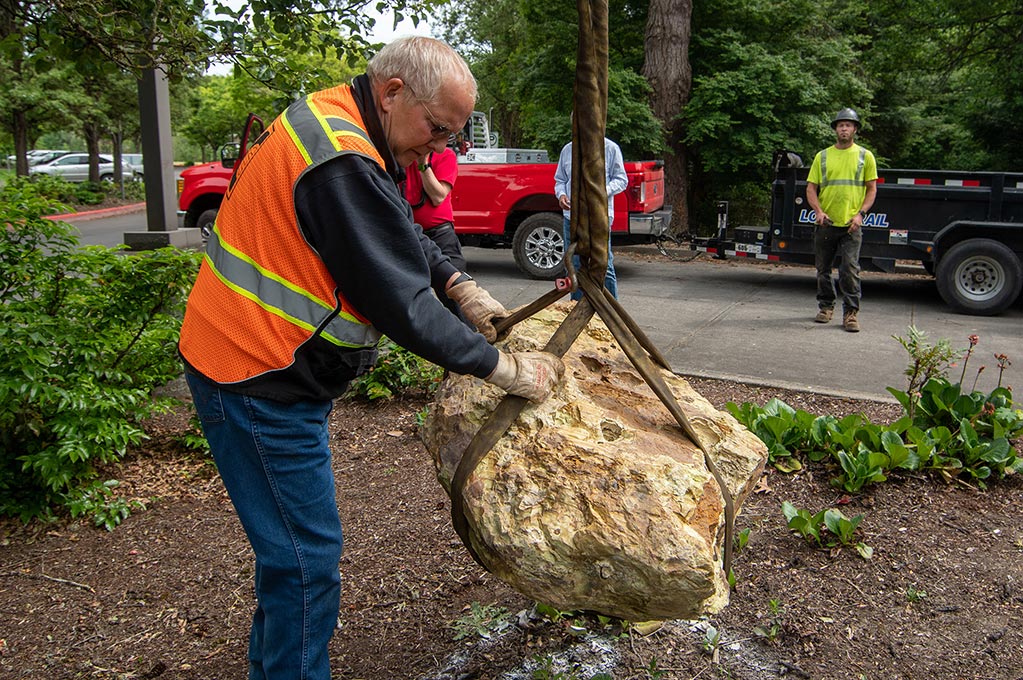One-ton chunk of rhyolite likely traveled hundreds of miles
The newest addition to the Tualatin Ice Age Floods Foundation’s collection of unique geological specimens is now on display for public viewing.
A one-ton chunk of volcanic rhyolite measuring roughly three feet long by two feet thick was lifted into place in front of the Tualatin Heritage Center on May 17, wrapping up a series of public events that began in Lake Oswego and ended in Tualatin. The boulder is an estimated 15,000-years old and geologists believe it made its way here from Eastern Oregon or even farther away on an ice raft as part of the great Missoula Floods.
“What this means for the Foundation is ‘Wow, we’ve got something very unusual here,’” Foundation Secretary Sylvia Thompson said outside the Heritage Center after watching a crew from Brian Clopton Excavating hoist the boulder into place.

In scientific terms, a rock of this type is known as an ice raft erratic, due to how it was transported and deposited randomly. The Heritage Center has other erratics on display, but they all originated more locally and are comprised mainly of granite, feldspar or a metamorphic rock known as argillite.
The new chunk of rhyolite, by contrast, is virtually unknown in the Cascades range, which is known for producing basaltic or andesitic lava flows. Rhyolite, said Portland State University geology professor and Foundation Board member Scott Burns, is normally more commonly found in the Ochocos or Blue Mountains, or even further east. It is a thick, sticky type of lava comprised of nearly pure silica. It is associated with violent volcanic eruptions and typically emerges from the magma chamber after significant outpourings of ash and pyroclastic flows.
“It comes out at the end of a very violent eruption, so the volcano that erupted here had huge amounts of ash and cinders and what we call pyroclastics flowing out,” Burns said. “The Cascades is much more low-key. This is from the John Day formation, we think. So, it is very, very violent, and at the end of the eruption, when all the ash has come out then this magma oozes out. It’s just rare on this side of the Cascades.”

The rhyolite erratic was discovered in Lake Oswego several months ago at the construction site of the new Lakeridge Middle School. There, site superintendent Jacob Parker of general contractor Skanska USA Building, noticed the highly unusual green and yellow coloration of a freshly excavated boulder, set it aside and sought further information.
“I walked through and examined all of the rocks we unearthed and this boulder stood out as very unique in color and texture,” Parker said. “I quickly realized it may have some historical or geological significance.”
The Tualatin Ice Age Floods Foundation is certainly glad Parker acted.
“This is either the second or the only rhyolite erratic around here,” Thompson said. “We just do not have this here. It’s an eastern Oregon type or further out. And most of the erratics that we get, a huge percentage of them are granite.”
On May 17, Lakeridge Middle School students joined television crews in a large news media event to celebrate the find. Afterward, the erratic was transported to Tualatin and lifted into place at the Heritage Center, where it will greet visitors and geology enthusiasts.
“I do a lot of stuff with the TV stations, and it worked, it was just wonderful to get the kids there, that’s the most important thing, to get the kids involved,” Burns said. “It was a media frenzy.”





















